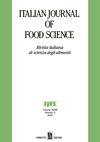Scrutinizing the antidiabetic, antidiarrheal, and anti-inflammatory activities of methanolic extract of pomegranate peel via different approaches
IF 3.3
4区 农林科学
Q2 FOOD SCIENCE & TECHNOLOGY
引用次数: 0
Abstract
The objective of the current study was to evaluate the potential of Punica granatum L peel in mice as an antidiarrheal and antidiabetic agent. In an antidiarrheal study, different doses (50, 100, 150, and 200 mg/kg) of methanolic pomegranate peel extract (PPE) were administrated to castor oil-induced (1 mL/kg) diarrheal mice. Mice administered loperamide hydrochloride (3 mg/kg) were treated as a baseline group. During the experiment, electrolyte and hematological levels were analyzed, and at the end, histopathology of the intestine was performed. For antidiabetic activity, PPE doses (50, 100, 150, and 200 mg/kg) and metformin hydrochloride were administered to alloxan-induced (150 mg/kg) diabetic mice groups, and biochemical and hematological parameters were analyzed. Liver histopathology was done at the end of the experiment. The study found that castor oil caused diarrhea and had a significant (p < 0.05) impact on hematological parameters and electrolyte levels, compared with negative control group. PPE helped to restore altered parameters to normal levels. Histopathology of positive control group revealed abnormal cell structures, with irregularly arranged villi, unclear mucosal architecture of the ileal section, and nuclei cells were damaged and prone to collapsing. Significant dose-dependent recovery was observed in PPE-fed mice groups. After inducing and confirmation of diabetes with alloxan, all groups, except the negative control group, had significantly high glucose levels (p < 0.05). Levels of C-reactive protein and bilirubin were significantly altered, but PPE and metformin hydrochloride showed potential to improve these parameters. In positive control group mice, liver histology showed microvesicular fatty changes throughout the acinus, reactive Kupffer cells, mid-portal inflammation, reduced portal triad, centrilobular visibility, and well-differentiated central vein with well-formed nuclei. Similarly, significant dose-dependent recovery was observed in PPE-administrated mice groups. These results demonstrated that PPE had promising antidiarrheal and antidiabetic potential.通过不同方法研究石榴皮甲醇提取物的抗糖尿病、止泻和抗炎活性
本研究旨在评估石榴皮作为止泻剂和抗糖尿病剂在小鼠体内的潜力。在止泻研究中,给蓖麻油诱导(1 mL/kg)腹泻的小鼠服用不同剂量(50、100、150 和 200 mg/kg)的甲醇石榴皮提取物(PPE)。给小鼠服用盐酸洛哌丁胺(3 毫克/千克)作为基线组。在实验过程中,对小鼠的电解质和血液水平进行了分析,并在实验结束时对小鼠的肠道进行了组织病理学检查。在抗糖尿病活性方面,给阿脲诱导(150 毫克/千克)的糖尿病小鼠组服用 PPE 剂量(50、100、150 和 200 毫克/千克)和盐酸二甲双胍,并分析生化和血液学参数。实验结束时进行肝组织病理学检查。研究发现,与阴性对照组相比,蓖麻油会导致腹泻,并对血液学参数和电解质水平有显著影响(p < 0.05)。PPE 有助于将改变的参数恢复到正常水平。阳性对照组的组织病理学显示细胞结构异常,绒毛排列不规则,回肠切片的粘膜结构不清晰,核细胞受损并容易塌陷。喂食 PPE 的小鼠组出现了显著的剂量依赖性恢复。用阿脲诱导并确认糖尿病后,除阴性对照组外,其他各组的血糖水平均显著升高(p < 0.05)。C 反应蛋白和胆红素水平明显改变,但 PPE 和盐酸二甲双胍显示出改善这些参数的潜力。在阳性对照组小鼠中,肝脏组织学显示整个acinus出现微囊状脂肪变化、反应性Kupffer细胞、门静脉中段炎症、门静脉三联征减少、中心叶明显可见、中心静脉分化良好且核形成良好。同样,在服用 PPE 的小鼠组中也观察到了明显的剂量依赖性恢复。这些结果表明,PPE 具有良好的止泻和抗糖尿病潜力。
本文章由计算机程序翻译,如有差异,请以英文原文为准。
求助全文
约1分钟内获得全文
求助全文
来源期刊

Italian Journal of Food Science
工程技术-食品科技
CiteScore
4.20
自引率
0.00%
发文量
33
审稿时长
>36 weeks
期刊介绍:
"Italian Journal of Food Science" is an international journal publishing original, basic and applied papers, reviews, short communications, surveys and opinions on food science and technology with specific reference to the Mediterranean Region. Its expanded scope includes food production, food engineering, food management, food quality, shelf-life, consumer acceptance of foodstuffs, food safety and nutrition, energy and environmental aspects of food processing on the whole life cycle.
Reviews and surveys on specific topics relevant to the advance of the Mediterranean food industry are particularly welcome.
 求助内容:
求助内容: 应助结果提醒方式:
应助结果提醒方式:


